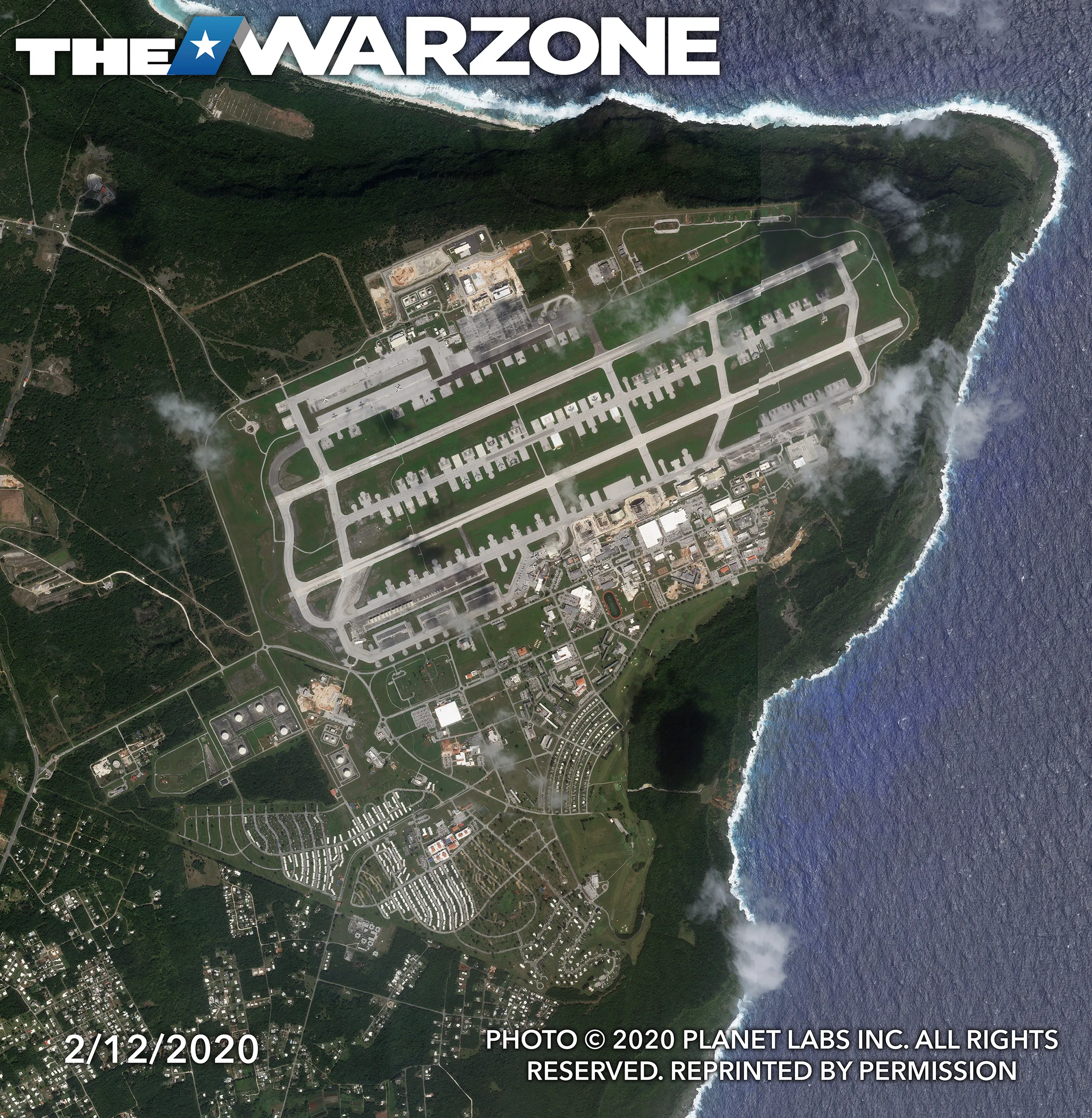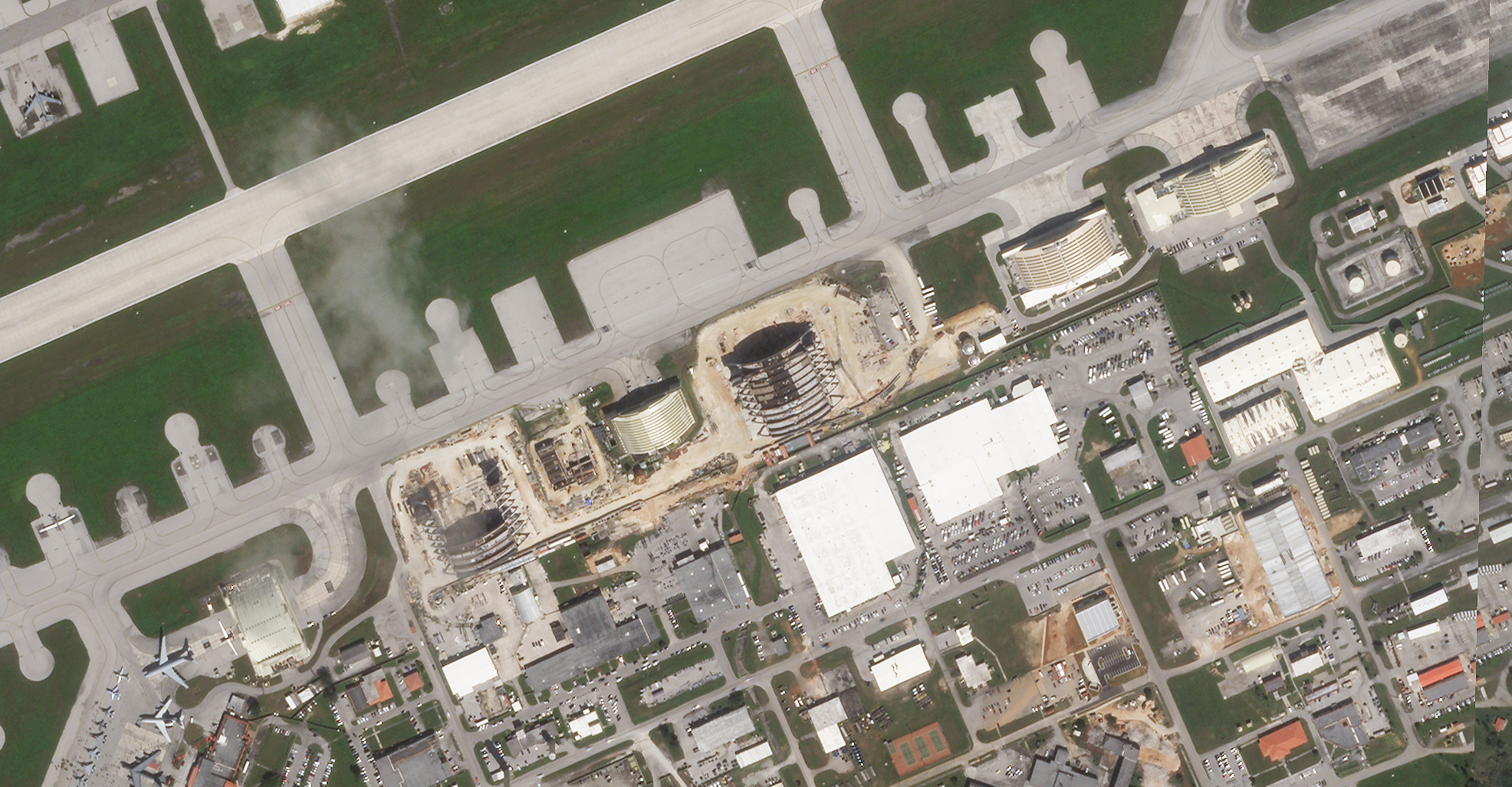Cope North, the huge multi-national air warfare exercise that calls Andersen AFB on the island of Guam home, is officially underway. The drills include the Japan Air Self Defense Force (JASDF) and the Royal Australian Air Force (RAAF), as well as the Pentagon’s own substantial airpower already deployed to the island outpost, and other units sent there just for the exercise. In total, some 100 aircraft and 2,000 personnel are taking part in this iteration of the operation, which includes everything from coalition counter-air to deep strike mission training to disaster relief, and pretty much everything in between. It’s all about getting the diverse international players to learn how to work seamlessly together during a crisis. Overall, Cope North is one of the region’s most impressive displays of air combat capabilities and the extent of its size translates well even from the point of view of low earth orbit.
In fact, our satellite tasking caught the ‘group image’ of the participating aircraft and personnel very close to the moment the image below was snapped, one that shows a dizzying array of air combat capabilities. These group images are a staple of Cope North, as well as many other international large force employment (LFE) exercises.



Andersen is incredibly strategic for the U.S. military. Its distance from potential adversaries, especially China and North Korea, would give it a degree of survivability during a conflict that is far greater than what America’s air bases in Japan and South Korea would face. The installation is truly gargantuan in scale and is set up to support all types of airpower, including that of a strategic nature. That’s why a continuous rotation of American bombers calls the base home.
At any given time, roughly four to six B-1Bs, B-2As, or B-52Hs are present at the base and capable of delivering a scalable offensive punch, from conventional to nuclear (at least in the case of the B-2A and B-52H), on a moments notice, anywhere in the region. At times, even all three of America’s bomber types have been on the island at the same time. During an actual crisis, Guam will serve as a key staging and power-projection hub for America and its allies.

Cope North, which was originally an exercise between the U.S. and Japan that took place quarterly in Japan, has a history dating back to the 1970s, but its presence at Andersen began back in 1999. Since then it has turned into an annual event, grown in size and complexity, and it has added a new participant, the Royal Australian Air Force. The operation is all about further developing tactics and procedures, and putting them to work across all three nation’s air arms so that they can fight and win as a team in the Pacific Theater of operations.
As for the aircraft participating, from what we know, Japan brought its F-15J and F-2 fighters, as well as its E-2C Hawkeye airborne early warning and control aircraft. In addition, the JASDF also brought Hawker U-125 maritime patrol aircraft, its indigenously developed C-2 cargo plane, and according to an Air Force press release, the country’s fascinating US-2 flying boat is also going to participate in aircrew recovery drills for the first time. The Aussies brought their E-7 Wedgetail, F/A-18 Hornet, and KC-30 Multi-Role Tanker Transport (MRTT) aircraft.
The U.S. leveraged its air power in the region, which includes F-16C/D, F-15C/D, F/A-18C/D, EA-18G, RQ-4, KC-135R, E-3G, and even C-12J aircraft, which are all taking part in the drills. Most notably, the exercise is supported by the 18th Aggressor Squadron and their eclectically painted F-16C/Ds that are normally based at Eielson AFB in Alaska. They provide a highly capable threat force for the players to deal with.

The B-52Hs that are already forward deployed to the island are also taking part. This is just the list as we understand it, it is possible that there are a few other participants that we cannot definitively state at this time, a couple of then seem to appear in the images below. Although presence at Andersen AFB alone does not mean that the aircraft or their personnel are players in the exercise itself.
You can view the full high-resolution satellite image exclusively obtained by The War Zone by clicking here. The one below has been downsized for posting in this article.

Here is what we see in terms of aircraft scattered around the huge installation:




It is also worth mentioning the large amount of construction that is ongoing at the base. Beyond another hangar facility being built on the north ramp area, on the southern main ramp, the construction of a pair of addition typhoon-hardened large hangars is still underway. Over the last 15 years, these types of hangars have replaced more traditional ones that were scattered across Andersen AFB’s southern ramp. The two that are under construction now have been so for years.


“This exercise is a model opportunity for our countries to participate in world-class training and expand engagements to strengthen our interoperability… It validates new ways to deploy and maneuver people and assets, which ultimately enhances our capacity and capability to foster a free and open Indo-Pacific” U.S. Air Force Colonel Scott Rowe, the director of the whole Cope North exercise, stated in a USAF press release. Telling by these images alone, just the logistics part of the exercise, getting all this hardware out to the middle of the Pacific, is probably worth doing in itself.
Cope North 2020 runs from February 12th through the 28th.
Contact the author: Tyler@thedrive.com
